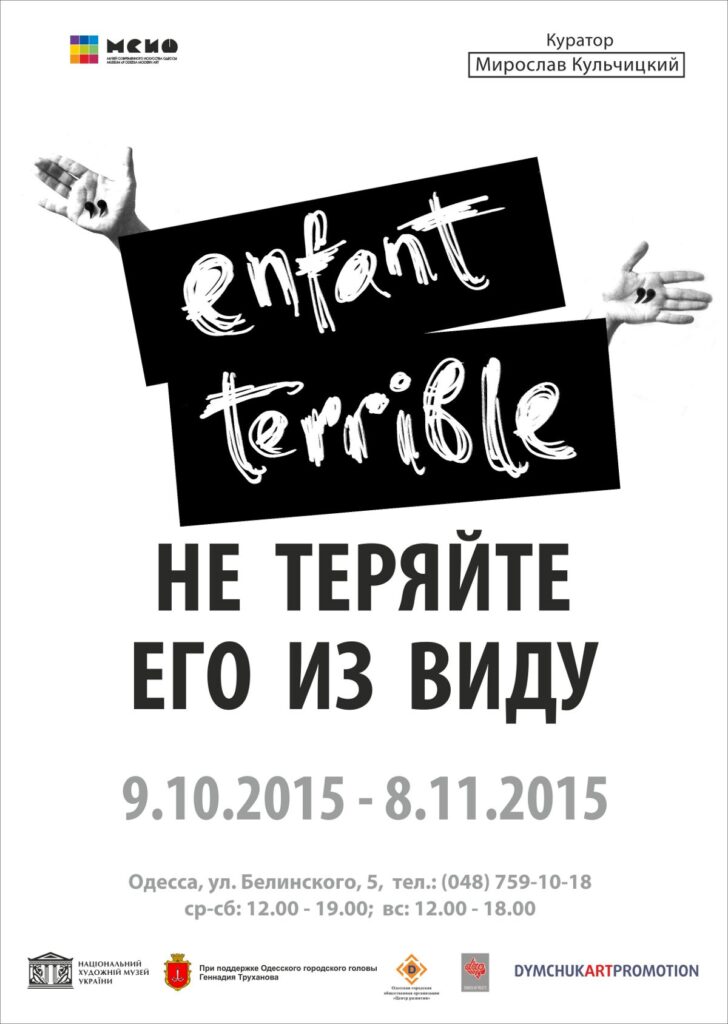“ENFANT TERRIBLE. Do not lose sight of him”
10.10.2015 2023-11-17 12:31“ENFANT TERRIBLE. Do not lose sight of him”

On 9 October 2015, the exhibition “ENFANT TERRIBLE. Do not lose sight of him”.
This exhibition is a phenomenon of the historical homeland of the project “ENFANT TERRIBLE. Odesa Conceptualism” project, which was successfully shown for more than three months in the country’s main museum, the National Art Museum of Ukraine.
Almost half of the halls of the NAMU were devoted to the history of Odesa conceptualism, the only artistic movement that originated (in the 80s of the twentieth century) in our city and became known far beyond Ukraine.
The paradox of the development of Odesa conceptualism is that for many years the names and works of Odesa artists were known in Moscow and Kyiv, New York and Berlin, but practically forgotten in Odesa. Only the consistent work of the MoOMA staff reminded Odesa citizens that in the field of art we are ahead of the rest of the world.
The year of birth of Odesa conceptualism is generally considered to be 1982. However, as early as 1972-73, Leonid Voitsekhov, the future informal leader of the group, created conceptual objects. And in the late 70s, according to Serhiy Anufriev, Odesa schoolchildren Volodymyr Fedorov and Oleksiy Kotsievsky “invented conceptualism”. By organising performances and happenings at school, composing absurd texts with pictures, they created a parallel reality for themselves, which they called “cretinistic realism”. Thus, boys’ games of hide-and-seek from the “dullness” gave impetus to the emergence of a new trend in art – “Odesa conceptualism”, which was finally formed in the 80s.
The year 1982 is generally considered to be the birth of Odesa Conceptualism. However, as early as 1972-73, Leonid Voitsekhov, the future informal leader of the group, was creating conceptual objects. And in the late 70s, according to Serhiy Anufriev, Odesa schoolchildren Volodymyr Fedorov and Oleksiy Kotsievsky “invented conceptualism”. By organising performances and happenings at school, composing absurd texts with pictures, they created a parallel reality for themselves, which they called “cretinistic realism”. Thus, boyish games of hide-and-seek from the “grey” gave impetus to the emergence of a new trend in art – “Odesa Conceptualism”, which was finally formed in the 80s.
Conceptualists ironically used linguistic clichés, slogans of mass culture and local folklore. Their hooligan-intellectual creativity conveyed, in Voitsekhov’s words, “…the ephemeral and fantastical atmosphere of Odesa in 1983-85, which we (S. Anufriev, L. Voitsekhov, Y. Leiderman, later L. Zvezdochetova, the Peppers (L. Skrypkina and O. Petrenko), I. Chatskin) threw around ourselves. Chatskin) inspired themselves around them… The group… ‘lost its way’… as a result of a comedy of errors played out near a ‘richly decorated’ chest, where we all hid one by one… It was stuffy and hot in the chest; through a crack in the aberrating mirage, abstract Moscow was visible, and the West stretched beyond Moscow…”. To achieve this mirage, in the second half of the 80s, Odesa artists gradually moved to Moscow, becoming the second wave of the world-famous Moscow conceptualism.
In the early 90s, conceptualism in its purest form came to an end. However, its traditions, techniques and methods can be traced in the works of the next generations of Odesa artists. And the period of Odesa conceptualism in the 80s is recognised as the stage of the birth of contemporary art in Ukraine.
The ENFANT TERRIBLE project would not have been possible without the support of a large number of concerned Odesa citizens and friends of the Museum. We thank the Mayor of Odesa, the National Art Museum of Ukraine, the Odesa Museum of Western and Eastern Art, galleries and private collectors, experts and leading artists from Ukraine and abroad.
We hope that thanks to our activities, the terribly talented and notorious child of Odesa Conceptualism will never again be lost from view by Odesa residents.
The team of the MoOMA dedicates the project to its late curator Myroslav Kulchytskyi.
